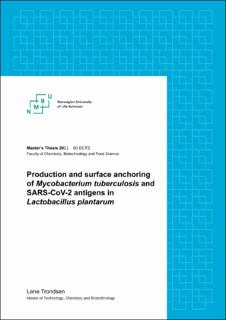| dc.contributor.advisor | Mathiesen, Geir | |
| dc.contributor.advisor | Vincent, Eijsink | |
| dc.contributor.advisor | Wiull, Kamilla | |
| dc.contributor.author | Trondsen, Lene | |
| dc.date.accessioned | 2021-04-27T19:09:05Z | |
| dc.date.available | 2021-04-27T19:09:05Z | |
| dc.date.issued | 2021 | |
| dc.identifier.uri | https://hdl.handle.net/11250/2739991 | |
| dc.description.abstract | Lactic acid bacteria (LAB) are considered good candidates for delivery of antigens because they are regarded as safe to consume by humans and can survive the rough conditions in the gastrointestinal tract, to mention some desirable traits. Lactobacillus plantarum has shown to be one of the most promising LAB as a vaccine deliverer. The inducible expression system pSIP has in this study been used to express the Mycobacterium tuberculosis antigens Ag85B, ESAT6 and Rv2660c (named H56) and the severe acute respiratory syndrome coronavirus 2 (SARS-CoV-2) antigens NTD and RBD in L. plantarum. In addition, the antigens were displayed at the surface of L. plantarum with different cell membrane and cell wall anchors. H56 antigens were displayed at the surface with a lipoprotein anchor (cell membrane anchor), LysM anchor and LPXTG anchor (cell wall anchors), while the SARS-CoV-2 antigens were displayed at the surface with a lipoprotein anchor and LPXTG anchor.
The vaccine candidates in this study were constructed because the world is in need of a new and improved vaccine against tuberculosis and due to the recently emerged worldwide pandemic COVID-19. Tuberculosis (TB) is a disease causing over one million deaths every year despite there already exists a vaccine against the disease, the BCG vaccine. The COVID-19 pandemic has taken over 2 million lives in less than a year and the world has been in desperate need of a vaccine. Fortunately, several successful vaccines have recently been approved against the disease.
In this study, three vaccine candidates against tuberculosis, and four vaccine candidates against COVID-19 were constructed. L. plantarum successfully produced both the TB antigens and the SARS-CoV-2 antigens and displayed them at the surface of the bacteria. Growth analyses showed that bacteria with cell membrane anchored antigens generally had a higher growth rate than bacteria with antigens anchored to the cell wall. However, bacteria harbouring the cell wall anchored antigens showed stronger fluorescent signal in flow cytometry assays, indicating more antigens were exposed at the surface. For the purpose of using these recombinant bacteria as vaccines, it is an advantage that the growth is as high as possible, and the antigens have to be exposed at the surface of the bacteria. Based on the characterization done in the present study, the most promising vaccine candidates against tuberculosis were L. plantarum harbouring the lipoprotein and LysM anchored H56, and against COVID-19, L. plantarum harbouring the lipoprotein anchored SARS-CoV-2 antigens. | en_US |
| dc.description.abstract | Melkesyrebakterier anses som gode kandidater for levering av antigener fordi de blant annet er betraktet som trygge å konsumere av mennesker og kan overleve de tøffe forholdene i mage-tarmkanalen. Lactobacillus plantarum har vist seg å være en av de mest lovende melkesyrebakteriene for levering av vaksiner. I dette studiet har det induserbare utrykkingssystemet pSIP blitt brukt til å utrykke Mycobacterium tuberculosis antigenene Ag85B, ESAT6 og Rv2660c (kalt H56) og SARS-CoV-2 antigenene NTD og RBD i L. plantarum. I tillegg ble antigenene eksponert på overflaten av L. plantarum ved hjelp av ulike cellemembran og cellevegg ankere. H56 antigenet ble ankret til overflaten med et lipoproteinanker (cellemembran anker), LysM anker og LPXTG anker (cellevegg ankre), mens SARS-CoV-2 antigenene ble ankret til overflaten med et lipoprotein anker og LPXTG
anker. | en_US |
| dc.language.iso | eng | en_US |
| dc.publisher | Norwegian University of Life Sciences, Ås | en_US |
| dc.rights | Attribution-NonCommercial-NoDerivatives 4.0 Internasjonal | * |
| dc.rights.uri | http://creativecommons.org/licenses/by-nc-nd/4.0/deed.no | * |
| dc.title | Production and surface anchoring of Mycobacterium tuberculosis and SARS-CoV-2 antigens in Lactobacillus plantarum | en_US |
| dc.type | Master thesis | en_US |
| dc.description.localcode | M-KB | en_US |

